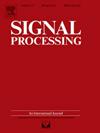Bistatic MIMO radar for exact near-field target localization with COLD arrays
IF 3.4
2区 工程技术
Q2 ENGINEERING, ELECTRICAL & ELECTRONIC
引用次数: 0
Abstract
Most existing near-field target localization algorithms are based on the Fresnel approximation model, which can lead to a decrease in parameter estimation accuracy. In this paper, we combine bistatic multiple-input multiple-output (MIMO) radar with concentered orthogonal loop and dipole (COLD) arrays to propose a six-dimensional (6-D) parameter estimation algorithm based on an exact near-field spatial propagation geometry model. The proposed algorithm first performs eigenvalue decomposition of the covariance matrix of the receiving array and utilizes the rotational invariance technique to obtain estimates of two-dimensional reception polarization angles (2D-RPA). Then, the unambiguous spatial amplitude attenuation factors and ambiguous spatial phase factors are estimated. Two overdetermined linear equations are constructed and solved with the estimated spatial amplitude attenuation factors to obtain coarse direction of departure (DOD), range from transmitter to target (RFTT), direction of arrival (DOA), and range from target to receiver (RFTR) estimation. Finally, the coarse estimates of DOD, RFTT, DOA, and RFTR are combined with the estimated ambiguous spatial phase factors to obtain the unambiguous spatial phase factors, thereby achieving fine estimation of DOD, RFTT, DOA, and RFTR. The proposed algorithm achieves automatically matching of 6-D parameters that is superior to exiting method, simulation results validate its effectiveness.
用于冷阵列近场目标精确定位的双基地MIMO雷达
现有的近场目标定位算法大多基于菲涅耳近似模型,导致参数估计精度降低。本文将双基地多输入多输出(MIMO)雷达与同心正交环偶极子(COLD)阵列相结合,提出了一种基于精确近场空间传播几何模型的六维(6-D)参数估计算法。该算法首先对接收阵列的协方差矩阵进行特征值分解,并利用旋转不变性技术得到二维接收偏振角(2D-RPA)的估计。然后,估计了无二义空间振幅衰减因子和模糊空间相位衰减因子。利用估计的空间幅度衰减因子,构造了两个过定线性方程,求解得到了粗估计的发射方向(DOD)、发射距离(RFTT)、到达方向(DOA)和目标距离(RFTR)。最后,将DOD、RFTT、DOA和RFTR的粗估计与估计的模糊空间相位因子相结合,得到明确的空间相位因子,从而实现对DOD、RFTT、DOA和RFTR的精细估计。该算法实现了六维参数的自动匹配,优于现有方法,仿真结果验证了该算法的有效性。
本文章由计算机程序翻译,如有差异,请以英文原文为准。
求助全文
约1分钟内获得全文
求助全文
来源期刊

Signal Processing
工程技术-工程:电子与电气
CiteScore
9.20
自引率
9.10%
发文量
309
审稿时长
41 days
期刊介绍:
Signal Processing incorporates all aspects of the theory and practice of signal processing. It features original research work, tutorial and review articles, and accounts of practical developments. It is intended for a rapid dissemination of knowledge and experience to engineers and scientists working in the research, development or practical application of signal processing.
Subject areas covered by the journal include: Signal Theory; Stochastic Processes; Detection and Estimation; Spectral Analysis; Filtering; Signal Processing Systems; Software Developments; Image Processing; Pattern Recognition; Optical Signal Processing; Digital Signal Processing; Multi-dimensional Signal Processing; Communication Signal Processing; Biomedical Signal Processing; Geophysical and Astrophysical Signal Processing; Earth Resources Signal Processing; Acoustic and Vibration Signal Processing; Data Processing; Remote Sensing; Signal Processing Technology; Radar Signal Processing; Sonar Signal Processing; Industrial Applications; New Applications.
 求助内容:
求助内容: 应助结果提醒方式:
应助结果提醒方式:


